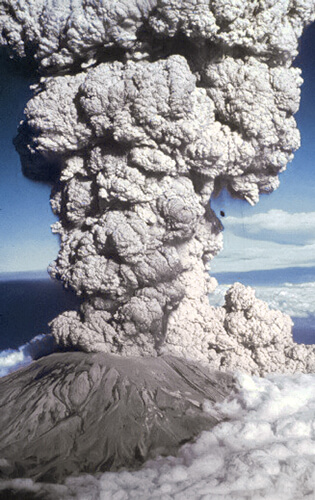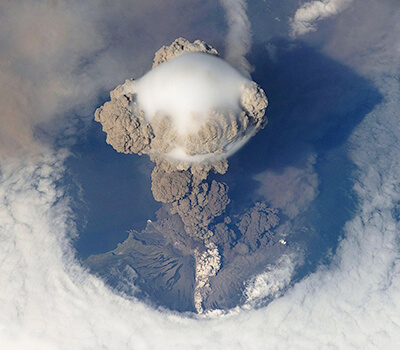This is a lesson summary. The full lesson can be viewed by purchasing an online course subscription.
Learning Objective
In this lesson we will learn about the different types of volcanoes, where they are found and the types of eruptions they are associated with.
Learning Outcomes
By the end of this lesson you will be able to:
- Describe the structure of volcanoes and the types of materials they eject.
- Differentiate between active, dormant and extinct volcanoes.
- Describe where volcanoes are found and explain why they occur at these locations.
- Compare the main types of volcanoes.
- Compare different types of magma and describe the types of volcanic eruptions they are associated with.

(Image: NASA, Wikimedia Commons)
Lesson Summary
- A volcano is a vent in Earth’s crust where lava, tephra, water vapour and other gases are ejected.
- Lava is magma that has reached Earth’s surface.
- Tephra refers to solid fragments ejected from volcanoes, including ash.
- An active volcano is a volcano that has erupted during the Holocene.
- A dormant volcano is an active volcano that is not currently erupting.
- An extinct volcano is an inactive volcano that is not expected to erupt again.
- Volcanoes occur at:
- Divergent plate boundaries, where they form as a result of diverging plates creating weakness in the crust.
- Continental-oceanic convergent plate boundaries, where they form as a result of subduction of an oceanic plate beneath a continental plate, leading to the creation of continental volcanic arcs.
- Oceanic-oceanic convergent plate boundaries, where they form as a result of subduction of an oceanic plate beneath another oceanic plate, leading to the creation of island volcanic arcs.
- Hotspots, where they form as a result of mantle plumes.
- All volcanoes consist of a vent and material that builds up around the vent.
- Other parts of a volcano include the magma chamber, conduit, throat, summit, crater and flanks.
- Structures that may also be present include parasitic cones, secondary vents, branch pipes, dikes and sills.
- The three main types of magma are:
- Mafic (basaltic) magma, which has a lower silica content, is hotter and less viscous, and contains less trapped gases. It is usually associated with effusive eruptions.
- Felsic (rhyolitic) magma, which has a higher silica content, is cooler and more viscous, and contains more trapped gases. It is usually associated with explosive eruptions.
- Intermediate (andesitic) magma, which has properties that are midway between those of mafic and felsic magma.
- The three main types of volcanoes are:
- Cinder cones (scoria cones) – small, conical volcanoes with steep sides and a bowl-shaped crater.
- These occur at constructive plate boundaries, destructive plate boundaries and hotspots and involve moderately explosive eruptions of mafic-to-intermediate lava, tephra and gases.
- Stratovolcanoes (composite volcanoes) – large, conical volcanoes consisting of alternating layers of rock and ash, often with a sunken crater called a caldera which can fill with water to form a volcanic crater lake.
- These occur at destructive plate boundaries and continental hotspots and involve very explosive eruptions of felsic-to-intermediate lava, tephra and gases.
- Shield volcanoes – very large, dome-shaped volcanoes with gently sloping sides, built up over many eruptions.
- These occur at constructive plate boundaries and oceanic hotspots and involve effusive eruptions of mafic lava.

A view of a volcanic eruption from the International Space Station.
(Image: NASA, Wikimedia Commons)
(Header image: Spotmatik, Adobe Stock)
